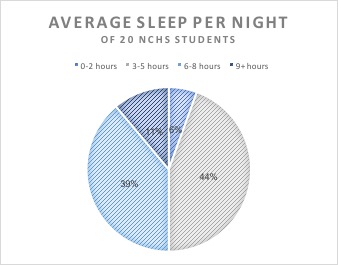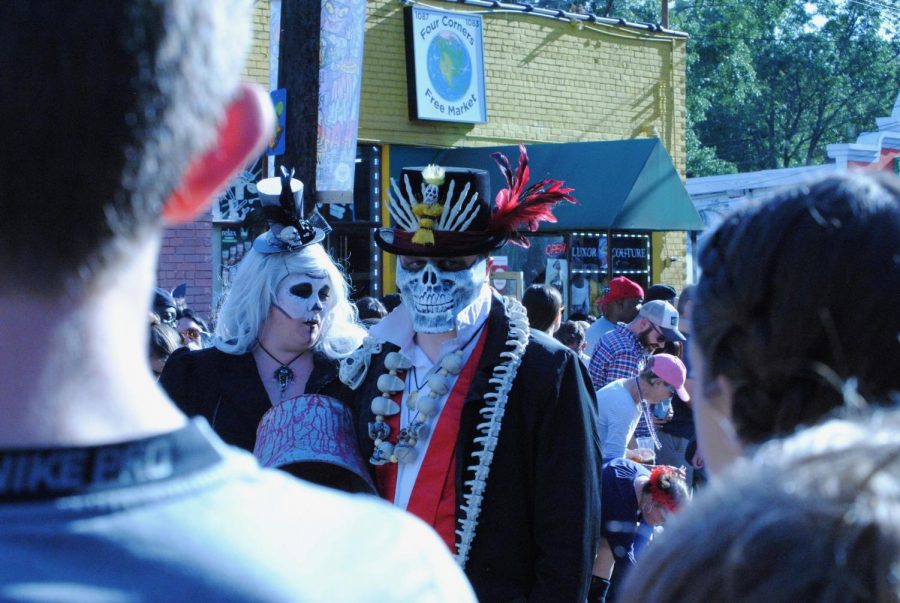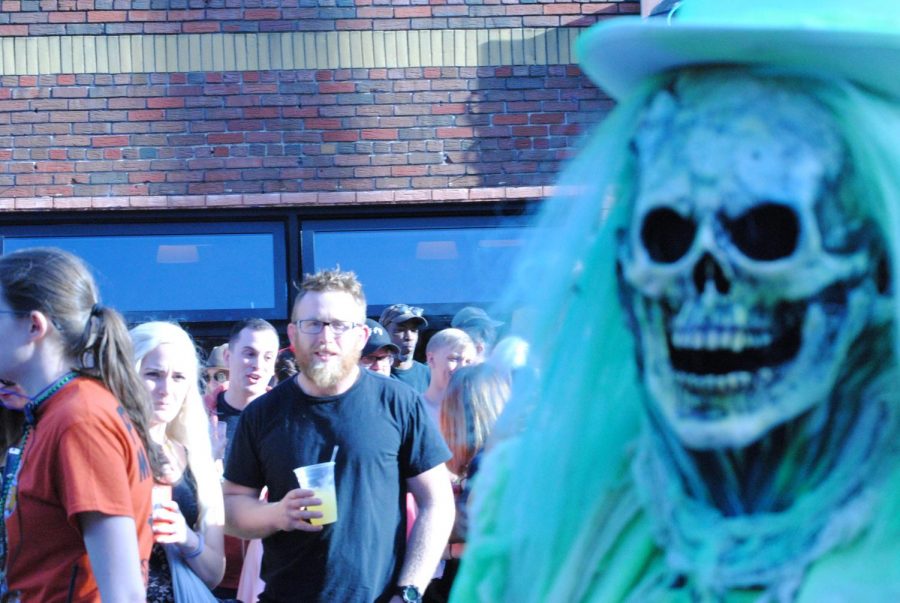Your donation will support the student journalists of North Cobb High School. Your contribution will allow us to purchase equipment and cover our annual website hosting costs.
Parasomnia: The undiagnosed sleep disorder that plagues some teens
December 19, 2017
Skeleton man stares directly into the eyes of the camera giving an intense gaze, igniting one’s fearful demise.
Imagine waking up in the center of Times Square, not remembering how or when you got there.
Imagine seeing a family member or loved one die right in front of your eyes.
Imagine feeling the pain of a stab wound while lying asleep at night.
Imagine experiencing parasomnia, a sleep disorder that people, especially teens, suffer with every night. Night terrors accompany parasomnia, and act as a nightmare with a more realistic feel while sleeping. People who experience night terrors usually wake up screaming, crying, or trembling with fear.
Sleep exists as an extremely important part of life, dictating how a person functions during the day. Millions of children and adults associate sleep with fear because of this debilitating and progressive disorder. Sometimes people affected refrain from sleeping two to three nights in a row to escape these terrifying experiences.
“I really don’t want to go back to sleep. I don’t ever want to sleep now, like I’m tired and I want to sleep, but I don’t because I know I will have a night terror,” sophomore Tali Porter said.
Most people believe that sleep consists of our bodies “turning off” for hours on end, and “turning back on.” Rather than a passive, consistent process, sleep contains complicated, defined lines that mark specific stages.
Sleep exists as active state of mind with our bodies moving frequently and our brain activity heightened as it prepares for the following day. During the day people exhibit beta and alpha brain wave (EEG) patterns. Beta waves contain the highest frequency and the lowest amplitude. People usually exhibit beta waves during day-to-day cognitive, sensory, and motor activities. Alpha waves present themselves during moments of relaxation, synchronizing and increasing in amplitude.
Stage one of sleep consists of theta waves, which slows the frequency from the relaxation state and increases the amplitude. Stage one of sleep and relaxation do not differ much, but stage two produces new unusual wave phenomenons: sleep spindles and K-complexes.These phenomenons occur periodically and define the second stage well. Sleep spindles creates sudden increases in wave frequency, while K-complexes increase wave amplitude. Considered the “lightest” stages of sleep, if someone wakes during stage one or two, they will not remember ever falling asleep.
Delta waves appear in the third and fourth stages of sleep and contain the highest wave amplitude, while moving the slowest. Stage three and four do not differ much, besides the fact that the fourth stage contains more delta waves. These waves put us in the deepest sleep, making it difficult to wake up, and easy to fall victim to parasomnias.
One more unique stage of sleep exists, called Rapid Eye Movement (REM) sleep in which a person experiences a similar to paralysation. This stage uses a combination of alpha, beta, and desynchronous waves.
Sleep follows stages one to four, and then circles back up through the stages, replacing stage one with REM sleep after the first cycle. This cycle takes approximately ninety minutes, and then repeats itself throughout the night with delta waves decreasing and REM increasing.
The active physiological state of mind you enter when you sleep repairs and performs a multitude of different important functions. Sleep affects learning, memory, growth and development, blood pressure, stress, metabolism, and hunger. However, sleep deprivation can increase a person’s risk of a cardiovascular disease, obesity, depression, and memory loss. According to The National Sleep Foundation, the annual costs associated with sleep deprivation and sleep disorder in the US, including sick leave, medical expenses, and lost productivity, exceeds over $100 billion.
“We see lots of kids in high school, and the problem is they don’t get a sufficient amount of sleep to stay alive, they all have sleep deprivation, so we did lots of research and we have lots of data and high school students need at least nine hours of sleep. This is absolutely important. You cannot cheat sleep, and if you don’t get enough sleep your cognitive function will go down, your memory will go down, everything will be a mess,” pulmonology and sleep disorders medicine specialist, Dr. Matin, says.
 Maddie Powers
Maddie Powers
In a survey conducted of 20 freshmen, sophomores, juniors, and seniors enrolled at NC, only 11% of these students sleep for at least 9 hours a night, as prescribed by Matin.
Parasomnias involve unwanted experiences, events, or dreams that occur while entering the different levels of sleep. Certain behaviors, abnormal movements, emotions, perceptions, or dreams may contain complexities and appear real or purposeful to others, although the person experiencing the parasomnia may not remember the event.
Twelve disorders exist that fall into the parasomnia category. These disorders include; sleepwalking, night terrors, confusional arousals, sleep-eating disorder, REM sleep behavior disorder, sleep paralysis, sleep hallucinations, exploding head syndrome, sleep talking, nightmare disorder, and bedwetting, each with their own level of intensity.
The most common type of parasomnia in children and teens label as night terrors. Night terrors consists of frightening dreams that causing the victim to wake up screaming, heart racing, kicking and thrashing their legs out of intense fear. Night terrors can sometimes pair with sleep hallucinations, which consists of an extremely realistic dream that usually involves all of your senses. The realism and feelings one receives from sleep hallucinations can traumatize and affect their everyday life, including people present in their life, how they interact with these people and the areas or locations they grew accustomed to.
Sleep paralysis occurs after a night terror or sleep hallucination, involving a feeling of stillness and paralyzation. According to the Thought Catalog and numerous other sources, people that experience sleep paralysis see a black figure hovering over them, looming and watching them sleep.
“It (the black figure) just kind of stares me down at night, and watches me, it could be representing my anxiety and depression, but I don’t know, ” said Porter.
Parasomnia puts a constant fear in someone’s head; even thinking about sleeping causes problems in their body, making them tired and moody almost all the time. It affects student’s schoolwork and habits, leaving them unable to reach for their full potential, unable to obtain their goals, solely because of this persistent terror running through their minds. Porter fears sleep and even fears her bed at night. With so much potential, so much she can do with her life, it hurts to let these parasomnias weigh down on her and disrupt the calmest part of her life, something millions look forward to every night, sleep.
“I like my bed. I like sitting in it and doing homework in it, but by the time I have to go to sleep, my bed is like my worst nightmare. I almost cry just by looking at it.” said Porter.
As Porter shared one of her less scary terrors, tears rolled down her face. She struggles with paranoia every day because of these night terrors; seeing her friends commit horrifying acts creates an overwhelming sense of distrust. It makes her look at her friends and family differently, even just for a couple of days.
“Sometimes I’ll have dreams and it will be regarding someone in school and I will truly believe it happened until I wake up and realize it was just a dream, but then I’ll question like, did that actually happen? I get to school and I will be with the person and I don’t know what to do, I don’t know whether I should confront the person about it. It confuses me and hurts me, especially if it is something bad, “ said Porter as she explains how it makes her look at her friends and family differently.
The image gallery below showcases images from the Halloween Parade in Little 5 Points. Halloween often displays in costume people’s deepest fears and nightmares. Parasomnia, an active disorder and more than just a dream, serves an experience that many suffer from each evening.




